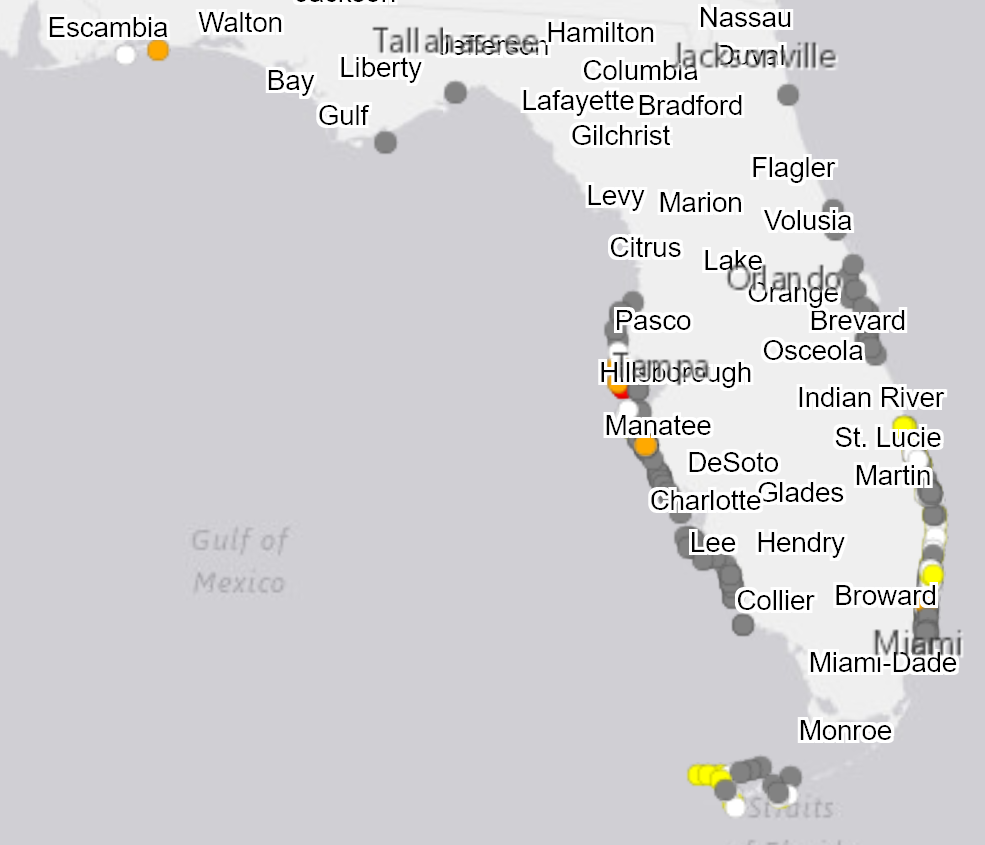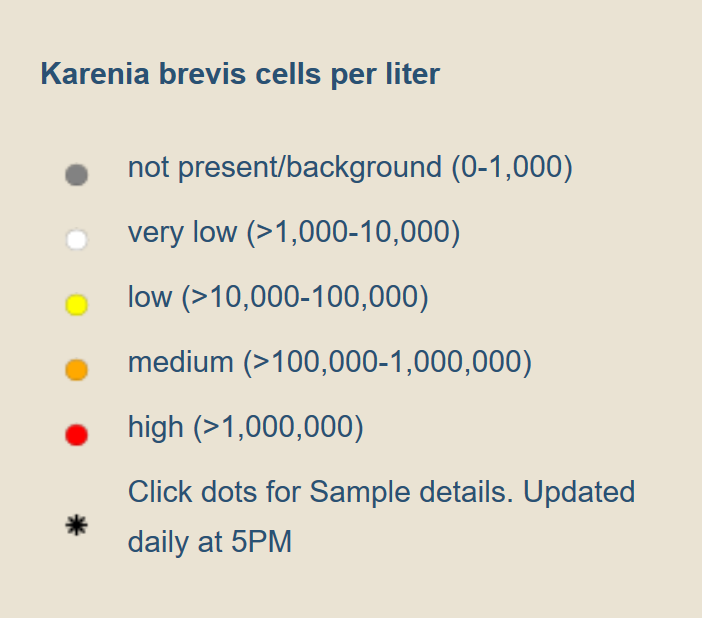Florida Red Tide Stinks. But even now, in the middle of one of the largest blooms most of us can remember, there is good fishing to be had. Data collected through the iAngler Tournament system over the past few years shows that fish are being caught (and released) in good numbers throughout the no-harvest zone, and that includes snook and red drum.
Make no mistake: there is no sugar-coating the impacts of red tide in Florida. When it is present where you are, you want to leave. Fish want to leave, and those that don’t often die. Birds, mammals, and a host of critters suffer. If we can find ways to decrease blooms, we should settle for nothing less. And until we do find ways, we need to keep searching, keep learning, keep trying.

It’s understandable that there is no shortage of bad news here in our beloved Sunshine State.
At Angler Action (Formerly SGF), we’ve been capturing data from recreational anglers since 2010, and tournament data since 2014. That year, we ran a total of about 10 tournaments through iAngler Tournament. We’ve grown a bit, and now on any given weekend we might have as many as 30 tournaments running live, all collecting valuable data that tells a story about our fish and anglers.
The system allows for a true catch-photo-release format, meaning anglers don’t need to kill, cull, or transport any fish. Just click a picture through a smart phone (which many of us do anyway), follow a few tournament directives, and hit ‘submit’. This can all be done with the fish out of water for just a few seconds, then released on the spot.

This October in the Tampa Bay area, we had the honor and pleasure of working with the National Pediatric Cancer Foundation (NPCF), a charity organization that has donated over $13 million to battle pediatric cancer since 1991. They host one of the biggest and most competitive inshore tournaments in the bay area, the Yerrid Foundation, NPCF Grand Slam Tournament (Grand Slam), so this tournament is a perfect place to catalog a good bit of angler data in a very organized way.
A group that has the courage to stand up to pediatric cancer is not about to let red tide push them around. While some local tournaments canceled or post-phoned this year, the Grand Slam– a long-time catch/photo/release tournament – held fast and kept their dates.

This is a very good thing for all involved. The charity raises a huge wad of money from this event, almost 250 anglers get to enjoy a day on the water, and more than 65 local guides were able to get a couple days of work in. During all of the negative national media Florida’s coastal waters have been getting lately, those are precious days of work. Plus, Angler Action collected quite a bit of much needed data from an area that has current local patches water that are saturated with red tide.
This really is significant for the guides. While chatting during captain registration before the Grand Slam, most of the guides mentioned that they have had cancellations of their scheduled charters. People are canceling their vacations to Florida because they hear all the fish are dead, some told me. Another said he had seven charters cancel in just the past two weeks. Seven!
While many of the anglers participating in the event traveled from quite a distance for the opportunity to fish an donate to a wonderful cause, many were local anglers, and they were not shy about discussing the horrific sights and smells near their homes. One showed me photos on his phone that were flat out disturbing, with literally thousands of dead fish floating in his canal, including snook ranging in size from about two inches to three feet long. (There was an up-side to his ghoulish photos -we learning that his canal, which has mangroves along one bank, is a very productive fish nursery and needs to be protected.)
Somehow, during registration, many captains were optimistic about their fishing odds in the Grand Slam. They’re biting hard a little further inside, a few quietly noted. There’s plenty of fish and clean water in the bay area if you are willing to look around or ask questions, some others agreed.
The team event scored points per inch for the longest of their snook, seatrout, and red drum. A team which caught a ‘slam’ of all three species had an advantage because they were able to score a fish in every category. If you only caught two species – say a snook and a trout – you get a zero for redfish and are not likely to come close to the winner’s circle.
What the numbers say
Looking at the Grand Slam data for the past three years, the results do show a decline in overall catch, but not by much. Over that time, the event averaged 66 active teams with a range of 65-67. The total number of fish reported in 2016 was 424, all snook, trout, or reds. Last year was the best of the three by far, when anglers logged 459 fish. This year the overall catch was 339 – a decline, but still a good number of fish. The number of team ‘slams’ each year has varied too, with 35 teams catching all three species in 2016, 43 teams in 2017, and 37 teams this past weekend. Less than last year’s bloated numbers, but more than 2016.
While the overall number of fish logged did decrease, it wasn’t by as much as you probably would have guessed if you only watched the news and didn’t spend any time on the local waters of Tampa Bay. Further, we don’t know for sure what else contributed to the change in numbers – they are close enough that one would be forgiven if they just assumed there was a better lunar phase last year, or tides were more favorable, or any number of reasons. Point is, plenty fish were caught, and nobody came back to the dock in need of a respirator.
Again – red tide kills fish. A lot of them. It needs to be taken seriously, and we need to push hard to find out if there is a way to push against a bloom when they move inshore and impact our game fish. But there are fish to catch, and to continue to protect.
Digging a little deeper into the numbers, you’ll see that last year, there was quite a spike in snook reported. In 2016, 168 snook made the leaderboard. In 2017, that increased to 212 snook. This year, it fell back down to 130 – the largest decrease of any species. Seatrout followed a similar trend, although less spectacular, as they went from 116 to 134, then down to 101 this year. Red drum were fairly consistent in numbers across all three years, from 115 to 112 to 108.

The average size of the fish reported have varied from year to year, and it will take a few more years to try to establish any kind of patterns. But three years of data gives us a start: reds decreased from 25.7 inches to 24.2 the first two years, then this year jumped up significantly to 27.4 – that’s over three inches per fish! The average snook stayed between 22 and 24 inches each year, and the average trout was even closer each year, ranging from 15 to 16 and change every year. The winning team score has increased each year, from 87 points in 2016, to 91.5 last year, to a whopping 99.25 this year. It will be interesting to see how many years it takes a Grand Slam team to top this number, as quite a few things need to go well to achieve such a score.
There are a lot of important points hiding in this data. First, it is clear that the fishing is indeed down a bit right now in Tampa Bay, which is currently experiencing pockets of active red tide blooms. At the same time, as mentioned earlier, there are still a lot of fish out there. If you have a trip planned with a guide, your chances are not bad at all – the guides who are on the water and talking to each other every day know where to go and can still catch fish. Of course, we all need to treat each fish like a newborn baby and go the extra mile to ensure a healthy release. Crimp your barbs, keep the fish in the water, don’t continue to fish where you see predators whacking your release, etc.
Because of the sensational way our media tends to cover these issues, without anglers reporting their catches like this we’d never know there was good fishing throughout most of Florida right now. Whether you log because you want to help managers, or you are keeping an iAngler personal log book, or you want to help understand habitats, the data has a ton of value for many, many reasons and without people fishing and logging, we’d never know.
We hope you continue to fish Florida, and log your trip info in iAngler when you do. When you do, you are helping us provide data that allows managers understand how best to deal with red tide today and in the future.
If you are intrigued by the Grand Slam tournament or just want to donate to a charity that has a clean, necessary mission, please do visit their website https://nationalpcf.org/. If you are a business owner or just someone who has had a good year financially, sponsoring this event is a feel-good tax deduction.
By the way, just up the road in Clearwater we hosted another inshore tournament the same weekend in iAngler Tournament, the Dorado Boats Fall Classic. This was just our second year hosting this tournament, which was a bit cozier than the aforementioned Grand Slam with 22 boats this year. Last year, there were 34 boats – but with the Grand Slam plying the same waters on the same day, the decline in boats might have had nothing to do with red tide. Interestingly, that tournament recorded nearly identical catch rates from last year to this: 1.2 fish logged per angler.
For more information about Angler Action, iAngler, or iAngler Tournament, contact Brett Fitzgerald at brett@angleraction.org.
